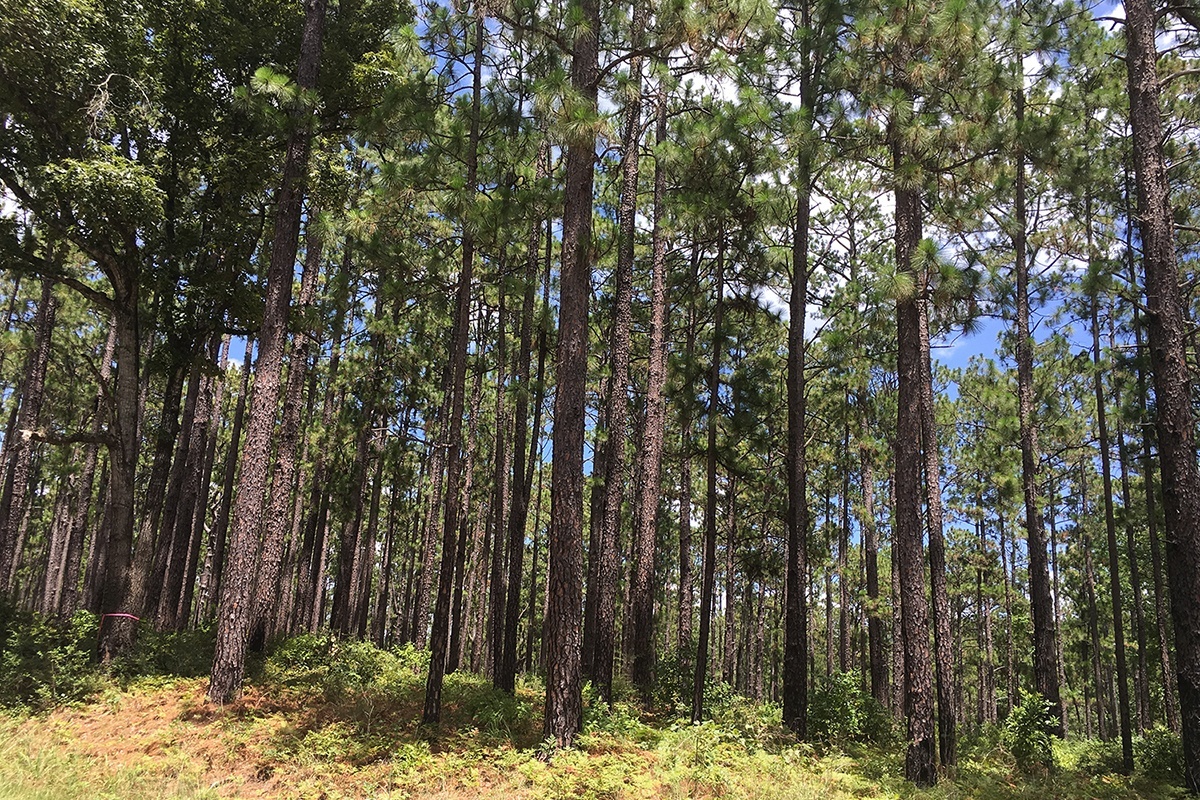Looking up from the middle of a stand of mature pine trees reveals strength, beauty and majesty. The blue of the sky pops through the treetops. Breezes sound like whispers. A layer of fallen needles muffles footsteps and amplifies the calls of birds and insects.
At one time, the longleaf pine forest covered more than 90 million acres, beginning in southeastern Virginia and extending south to Florida and west to East Texas. Today, only 3.3 million acres remain, with fewer than 45,000 acres in Texas. In much of the region, long-leaf pine has been replaced by the faster-growing yellow pine or loblolly pine. Maintaining the longleaf legacy while managing these more commercially expedient varieties is among the challenges that the Texas A&M Forest Service faces.
Protecting the ecosystem of every forest in the state is the forest service’s mission. Tom Boggus, Texas state forester and director of the Texas A&M Forest Service, leads a staff of 550 that oversees more than 60 million acres of forestland. Only Alaska has more.
Ninety-six TFS offices dot the state, and the agency works with a network of organizations to provide services that range from wildfire prevention to estate planning.
“We leverage ourselves,” Boggus says. “We train and equip people in the community so Texans can take care of themselves.”
The timber industry also falls under the TFS umbrella. Even though forests make up less than one-third of the state, timber is an important industry. Texas encompasses more than 11 million acres of privatedly owned productive timberland, and in 2014 the forest sector created a total economic impact of more than $30 billion as it supported nearly 140,000 jobs.
Even though East Texas is known for forests, Central and West Texas contain 49.7 million acres of forest. Almost 95 percent of the forestland in the area is privately owned.
TFS’ role as manager and conservationist is evident in its efforts to restore longleaf pine. The old growth of longleaf pine forest timber fueled the new growth of the American South:
Lumber mills, railroads and entire communities relied on the longleaf.
Now, a drive through the Pineywoods of East Texas most likely features the faster-growing loblolly pine. Just a century ago, the longleaf pine tree was the most prominent and desirable of the species. To help preserve existing stands of longleaf pine, and encourage the planting and growth of more, TFS works with the Natural Resources Conservation Service, National Wild Turkey Federation, the Nature Conservancy, U.S. Forest Service and other agencies.
All these conservation-focused organizations work closely with landowners and industry heavyweights such as International Paper to increase longleaf pine acreage and support the wildlife that depends on it. More funding has become available to assist landowners in preserving their forest-based income and to sustain healthy longleaf forest. Successfully managing the timber industry is a shared goal among landowners and support groups.
Simon Winston of Lufkin is one of the landowners who works with TFS. Driving through his tree farm, one sees lush stands of loblolly and longleaf pine in various stages of growth. His timber properties are considered the gold standard for land conservation and management, and his success has been acknowledged with the Leopold Conservation Award, administered through the Texas Parks & Wildlife Department. His well-maintained longleaf pine stands look more like a park than a wild forest. Winston says even before funding and research was shared with landowners like him, he was concerned about conservation.
“Deer, birds, songbirds, ground-nesting birds—they all do better when the property is managed correctly,” Winston says.
One controversial component of proper management is the use of prescribed burns, which frighten many landowners but are necessary for optimum growth of longleaf pine.
Prescribed burning mimics the important wildfire cycle. A low understory keeps the fires that occur naturally from burning too high or too hot. “It keeps your forest from burning up catastrophically on the timber side,” says Winston, who alternates burning acres on his property. “Plus, it keeps the invasive species down if you are trying to grow timber. If you knock that back, your timber will grow better.”
TFS helps landowners with the important work of developing strategies. “We help them to develop a plan and to help them achieve the goals they want for their land,” Boggus says. “We try to give them land-management tools to help them accomplish their objectives.”
These plans are created at no charge to the landowner, and Boggus says 97 percent of the plans created by his office are implemented by landowners to some degree. To restore the long-leaf pine, his office needs to reach contiguous landowners throughout the eastern part of the state.
The ecosystem in the longleaf pine forest is second only to the Amazon rainforest in biodiversity, and over the past 20 years, funding has begun to catch up with the interest in preserving it. This helps agencies such as TFS collaborate effectively with landowners working to maintain the health of the ecosystem.
Even though it is easy to notice the loss of the towering pine trees that can grow more than 100 feet tall and live for 500 years, it is often more difficult to see the loss of habitat for hundreds of species of birds, animals and plants.
White tail deer, bobwhite quail, indigo snakes and wild turkeys are all native to long-leaf forests, and the restoration of the forest helps maintain a healthy population.
Wendy Ledbetter has been working with the Nature Conservancy on the longleaf initiative for almost 25 years and has seen how working with the landowner’s goals in mind has helped move many stakeholders toward more successful conservation.
“If they are a timber investment management group, they are managing property for clients to achieve a financial return,” Ledbetter says. “While they may have biological objectives and goals, they also have an obligation to meet financial goals. That puts additional obligations on them,” she says. “Within this group, we are trying to find what can we agree on.
“Within the last several years, the support, funding and attention given to the longleaf ecosystem from federal funding to private funding has increased. Everybody is communicating more, and the resources and knowledge are being shared.”
Pine is still in high demand commercially. The wood from longleaf pine differs from other woods. It is slow to rot, so it was frequently used in boatmaking.
In the early days of the East Texas timber industry, the longleaf tree was valued beyond the wood it produced. For up to 20 years before harvest, a tree could be tapped for resin, which was then distilled into turpentine. Rosin, used to increase the friction between bows and strings on musical instruments and by gymnasts and bowlers to improve their grips, is the material left over after the distillation of the turpentine. Pine tar and pine pitch—made from heating sap drippings—was used to waterproof seams and joints, such as on boats and buckets.
To support the growing industry, timber mills sprang up and spawned new towns. The mills needed a way to transport their forest treasure, and railways—with ties made from the same virgin pine—formed the infrastructure that made it possible.
Conservationists remain optimistic, and those working toward reforestation are hopeful about a return to the glory days of the longleaf pine in Texas. Alan Shadow, plant manager for the National Resources Conservation Service, says it isn’t too late for the longleaf pine.
“It’s never too late for Mother Nature,” Shadow says. “She’s resilient.”
——————–
LaDawn Fletcher is a Houston-area writer who enjoys writing about Texas.


